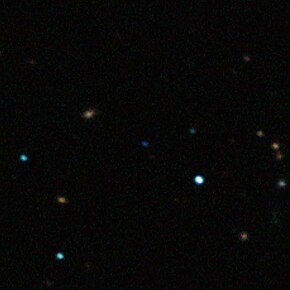


The small dim blue dot in the center of this image (click to enlarge) is captured by the SOFI instrument on ESO's New Technology Telescope at the La Silla Observatory and shows the free-floating planet CFBDSIR J214947.2-040308.9, in infrared light.
| |
| Discovery[1] | |
|---|---|
| Discovered by |
|
| Discovery date | 2012 |
| Direct imaging | |
| Physical characteristics | |
| Mass | 4–7 Jupiter masses |
| Temperature | ~700 K |
Spectral type | T7 |
CFBDSIR 2149-0403 (full designation CFBDSIR J214947.2-040308.9) is a free-floating planetary-mass object or possibly a high-metallicity, low-mass brown dwarf in the constellation Aquarius. Originally, it was thought to be part of the AB Doradus moving group (ABDMG) as indicated by its position and proper motion,[1][2] but the same team that discovered the object and conjectured its membership in the group has now rejected that hypothesis due to newer measurements. Without that membership, the age and mass of the object cannot be constrained.[3] There is insufficient evidence to demonstrate that CFBDSIR 2149-0403 formed as a planet and was subsequently ejected.[citation needed]
CFBDSIR 2149-0403 was discovered by the Canada-France Brown Dwarfs Survey, a near-infrared sky survey, and confirmed by WISE data.[1] Philippe Delorme, of the Institute of Planetology and Astrophysics of Grenoble in France and his team, including researchers at Université de Montréal in Canada, detected CFBDSIR2149's infrared signature using the Canada-France-Hawaii Telescope. They then examined the body's properties with the European Southern Observatory's Very Large Telescope in Chile.
If this object is actually a rogue planet (which has not been decisively demonstrated), then it is among the closest that has ever been spotted.[4] If the object belongs to the ABDMG then its distance is estimated to be 40±4 parsecs (130±13 light-years) from Earth; other possible estimates range from 25 to 50 parsecs.[1] The closest confirmed rogue planet is PSO J318.5-22.[5]
In the discovery paper, CFBDSIR 2149-0403 was claimed to possibly be a kinematic member of the AB Doradus moving group (ABDMG). The ABDMG appears to be similar in age to the Pleiades,[6] which has a lithium-depletion boundary age of 130±20 Myr.[7] If CFBDSIR2149 is indeed associated with the ABDMG, then it is similarly young. However, with Delorme's team now rejecting that hypothesis, estimates are either under 500 million years as a rogue planet with mass between 2 and 13 Jupiter masses, or else a two- to three-billion-year-old brown dwarf with mass between 2 and 40 Jupiter masses. The object shows signs of low gravity (brighter K band in the near-infrared), which could be attributable to youth.
Spectroscopy observations have found light absorption by gaseous methane and water in the object's atmosphere.[1]
|
2012 in space
| ||
|---|---|---|
2013 » | ||
| Space probe launches |
| |
| Impact events |
| |
| Selected NEOs |
| |
| Exoplanets |
| |
| Discoveries |
| |
| Comets |
| |
| Space exploration |
| |
| ||